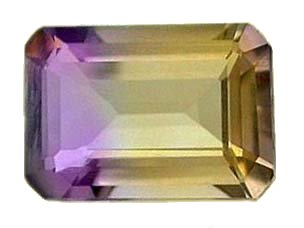 |
| A faceted example of ametrine Photo by De Wela49 |
Ametrine
is a variety of colored quartz where one end of the crystal is amethyst colored
and the other end is citrine colored. Most of these stones are found in Bolivia Russia
In 1994 a Russian chemist perfected a method to make
multicolored quartz crystals in a pressurized vessel. These stones are later
subjected to radiation that brings out the typical Ametrine colors. It is easy
to detect these stones because in nature neither yellow-green nor gold-blue
exists. In nature but artificial ametrine can also be created by treating an
amethyst crystal on one end with heat. Since quartz is a poor conductor of heat
only one end of the crystal that has been heated will change color.
 |
| An example of ametrine from Bolivia. Photo by Ra'ike |
The most probable cause of a bi-colored amethyst crystal is
by differential heat that is applied to one end of the crystal; in the case of
Bolivianite causing a temperature differential across the length of the crystal
will create a bi-colored stone.
Most of the Ametrine enters into trade comes from a single mine
in Bolivia Brazil India
 |
| An ametrine crystal also from Bolivia Photo by Rob Lavinsky |
Typically Ametrine is faceted into a rectangular shape with
a 50-50 combination of amethyst and citrine showing its bicolor nature. There
are times when there is a checkerboard pattern of facets that is added to the
top of the stone to increase the natural light reflection. This stone can also
be cut in such a way as to blend the two colors creating a mixture of yellow,
purple, and peach tones in the stone. Ametrine is also a popular stone among
artistic cutters and carvers that like to play with the various colors creating
landscapes from the stone.
When buying one of these stones the buyer has to remember
that at a Moh’s hardness of 7 it is not a particularly durable stone that
should not be used in rings that are going to be worn steadily. This tone is
more suitable for broaches and pendants. You can buy this stone in just about
any size or shape but remember the color contrast stands out better in stones
over seven carats in size.
Excellent, John. I did not know you could create this characteristic using heat. I'll have to try that sometime!
ReplyDeleteSuch an excellent blog. Thanks to the author for sharing such information with us. Yellow topaz played a vital role in our life. Visit our topaz stone jewelry collection at the best price.
ReplyDelete